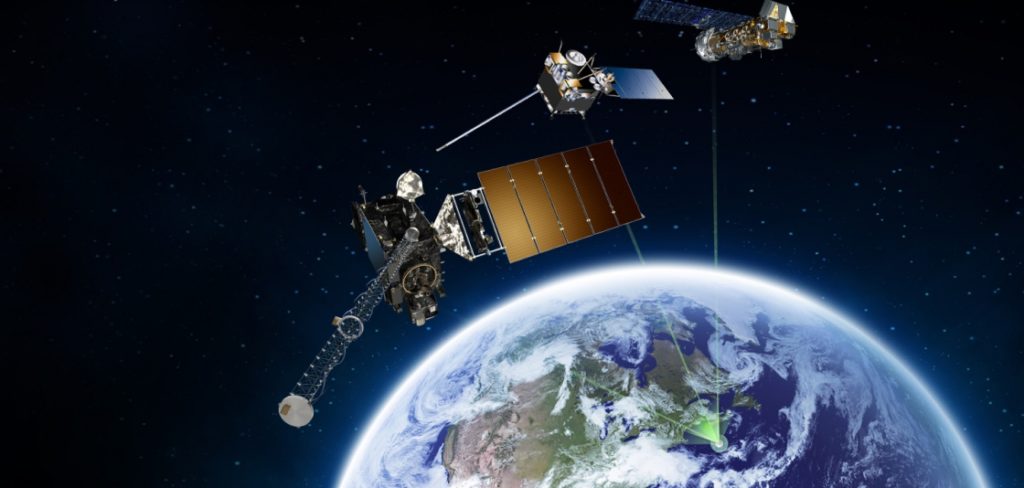Latest News

NOAA polar orbiting (right), geostationary (middle), and the soon to be launched GOES-R (left) satellites are part of the SARSAT constellation. Photo: NOAA
[Via Satellite 09-23-2016] The U.S. National Oceanic and Atmospheric Administration (NOAA) needs to ensure its timelines for launching and obtaining satellite information are accurate, clear and fully documented, according to a new Government Accountability Office (GAO) report. In doing so, and providing more accurate and analyzed data, GAO believes NOAA and Congress, which funds NOAA missions, will be able to better evaluate the life of a spacecraft and requisite funds to launch new satellites when necessary.
NOAA is responsible for launching and maintaining several weather-related satellites and currently manages two weather satellite programs that provide critical environmental data used in weather forecasts and warnings: a geostationary program — Geostationary Operational Environmental Satellites (GOES )— and a polar-orbiting satellite program — the Joint Polar Satellite System (JPSS). GOES satellites provide the kind of continuous monitoring necessary for intensive data analysis while JPSS is a collaborative program between NOAA and NASA that gathers global measurements of atmospheric, terrestrial and oceanic conditions. These measurements feed into forecasts for severe weather, such as hurricanes, tornadoes and blizzards, and assessments of environmental hazards such as droughts, forest fires, poor air quality and harmful coastal waters.
NOAA has historically relied on its own satellites to provide space-based weather data. Only in recent weeks has the agency purchased satellite weather data from commercial providers, having recently announced contracts with GeoOptics and Spire for Global Positioning System Radio Occultation (GPS-RO) data. For its own satellites, NOAA is currently working to acquire the next generation of satellites to replace existing spacecraft that are reaching the end of their mission lives. However, GAO found that NOAA could do a more coherent job of publishing new timelines for these replacements, called flyout charts, depicting its expectations for how long its operational satellites will last and when it plans to launch new satellites. NOAA uses these flyout charts to support budget requests, provide status reports, and facilitate appropriations discussions with congressional committees, as well as alert satellite data users on when they will need to upgrade their systems.
The 86-page report found that while the agency has a process for updating flyout charts, it is not established in its policy. GAO also found that while NOAA has made several updates to its charts, it has not consistently and accurately updated them, which is skewing data on satellite life-spans.
“NOAA updated the geostationary and polar-orbiting flyout charts three times between March 2014 and January 2016. Key changes included adding newly planned satellites; removing a satellite that reached the end of its life; and adjusting planned dates for when satellites would launch, begin operations, and reach the end of their lives,” the report said.
This includes one set of changes between April 2015 and January 2016, in which NOAA extended the life of older polar-orbiting satellites by one year, added a new fuel limited life period to its most recently launched satellite, the Suomi National Polar-orbiting Partnership (S-NPP), and changed the launch date and the end- of-life date for another satellite, the JPSS 2.
However, in its efforts to provide updated flyout charts to Congress, GAO finds NOAA has not consistently ensured that the data were supported by stringent analysis of the satellites’ health and availability. Without requiring that the satellite programs conduct regular assessments of satellite availability, it is difficult to determine how long satellites will last. It also found the reports were not accurate and consistent with supporting program data, clear in how a satellite’s extended life is portrayed or fully documented.
“Part of the reason for these issues is that NOAA has not established a policy that includes these steps. Until NOAA addresses the shortfalls in its practices and updates its policy to help ensure the flyout charts are accurate, consistent, and well-documented, it runs an increased risk that its flyout charts will be misleading to Congress and may lead to less-than-optimal decisions,” the report says.
In an effort to remedy this, NOAA recommends several executive actions, including:
- Requiring satellite programs to perform regular availability assessments and use these analyses to inform the flyout charts and support its budget requests;
- Ensuring that flyout chart updates are consistent with supporting data from the program and from satellite availability assessments;
- Establishing and implement a consistent approach to depicting satellites that are expected to last beyond their design lives;
- For each flyout chart update, maintaining a complete package of documentation on the reasons for any changes and executive approval of the changes; and
- Revising and finalizing the draft policy governing how flyout charts are to be updated to address the shortfalls with analysis, accuracy, consistency, and documentation noted in the above recommendations.
In complying with these recommendations, GAO believes NOAA can avoid any future surprises like insufficient funding or coverage, such as that with their JPSS program, which is facing gaps in coverage as a result of aging polar satellites.
Get the latest Via Satellite news!
Subscribe Now